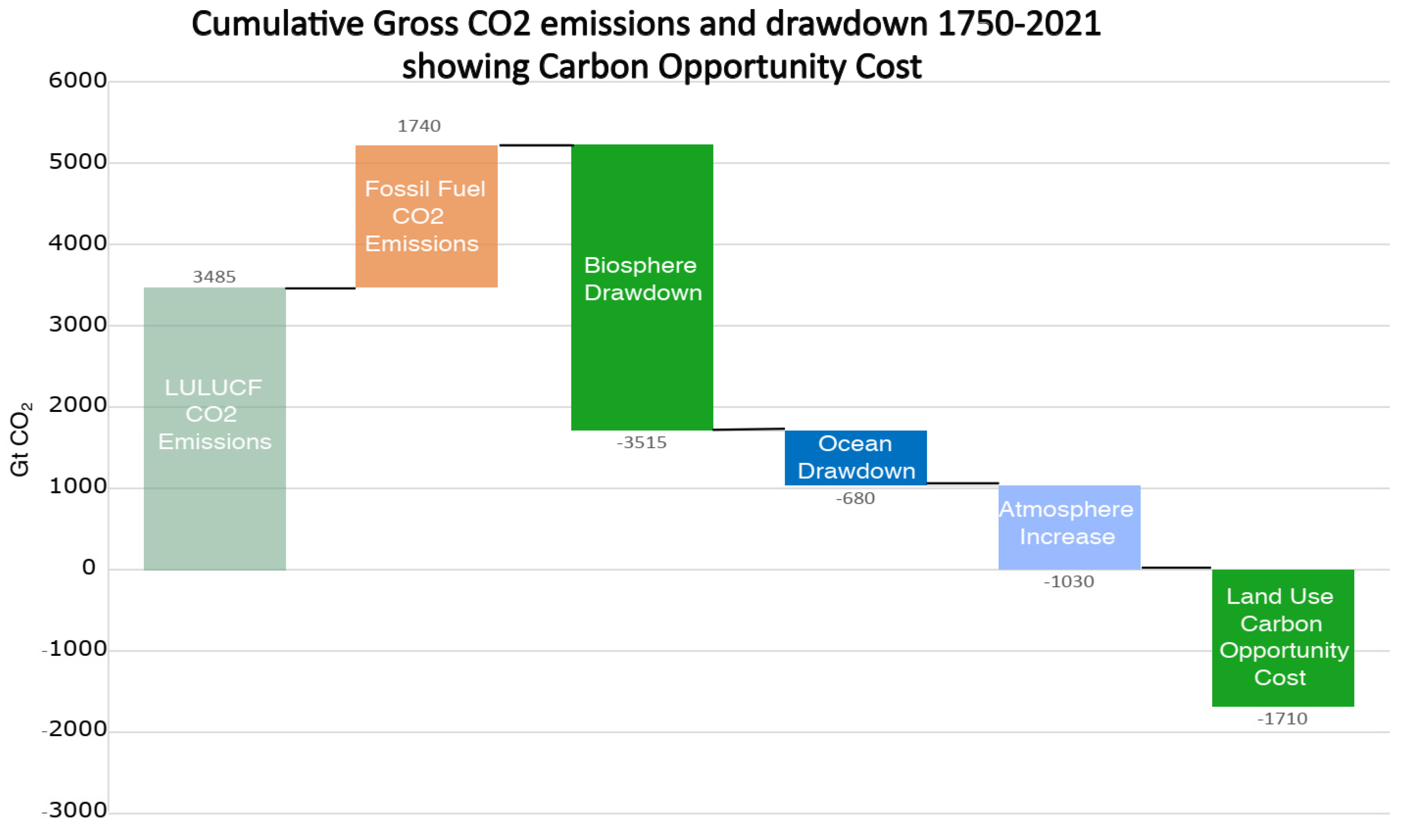Submitted:
27 October 2023
Posted:
30 October 2023
Read the latest preprint version here
Abstract
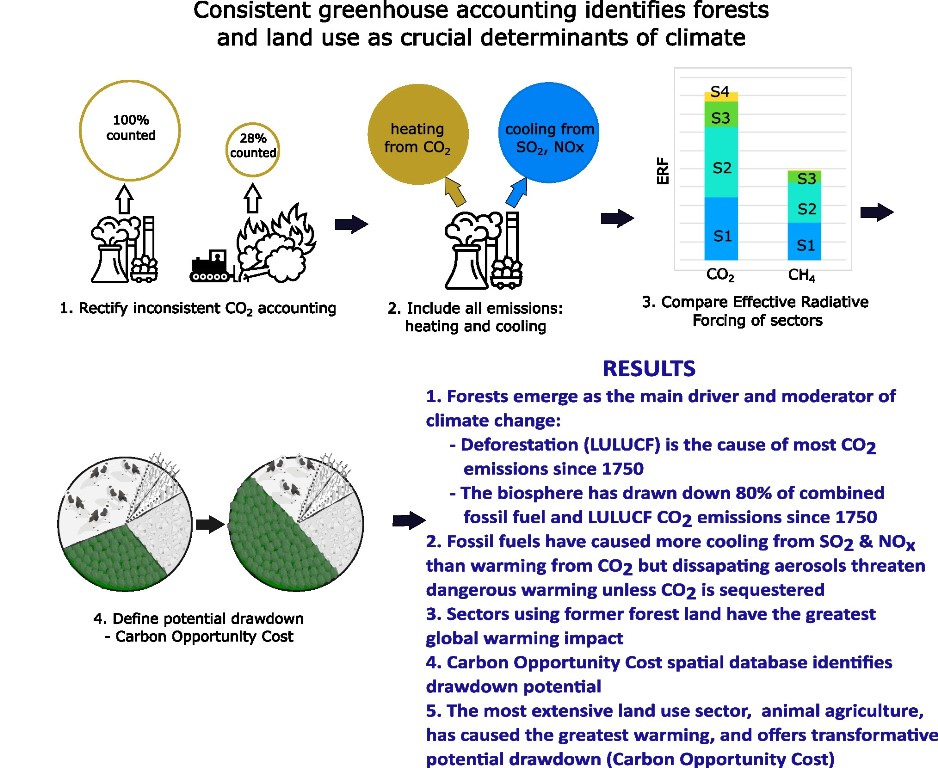
Keywords:
1. Introduction
1.1. Consistent CO2 Emissions Accounting
1.2. Consolidating ‘Intact’ and ‘Managed’ Land Sinks and Emissions
1.3. Rectifying IPCC Partial Accounting
1.4. Less Contentious Comparison of Greenhouse Gases and Sectors
1.5. Transparent Agriculture Emissions
1.6. Carbon Opportunity Cost and Accounting Framework
1.7. Accounting for Drawdown
2. Materials and Methods
2.1. Errors and Accuracy
2.2. Data Sources
2.3. Attribution of radiative forcing and warming to sectors
3. Results
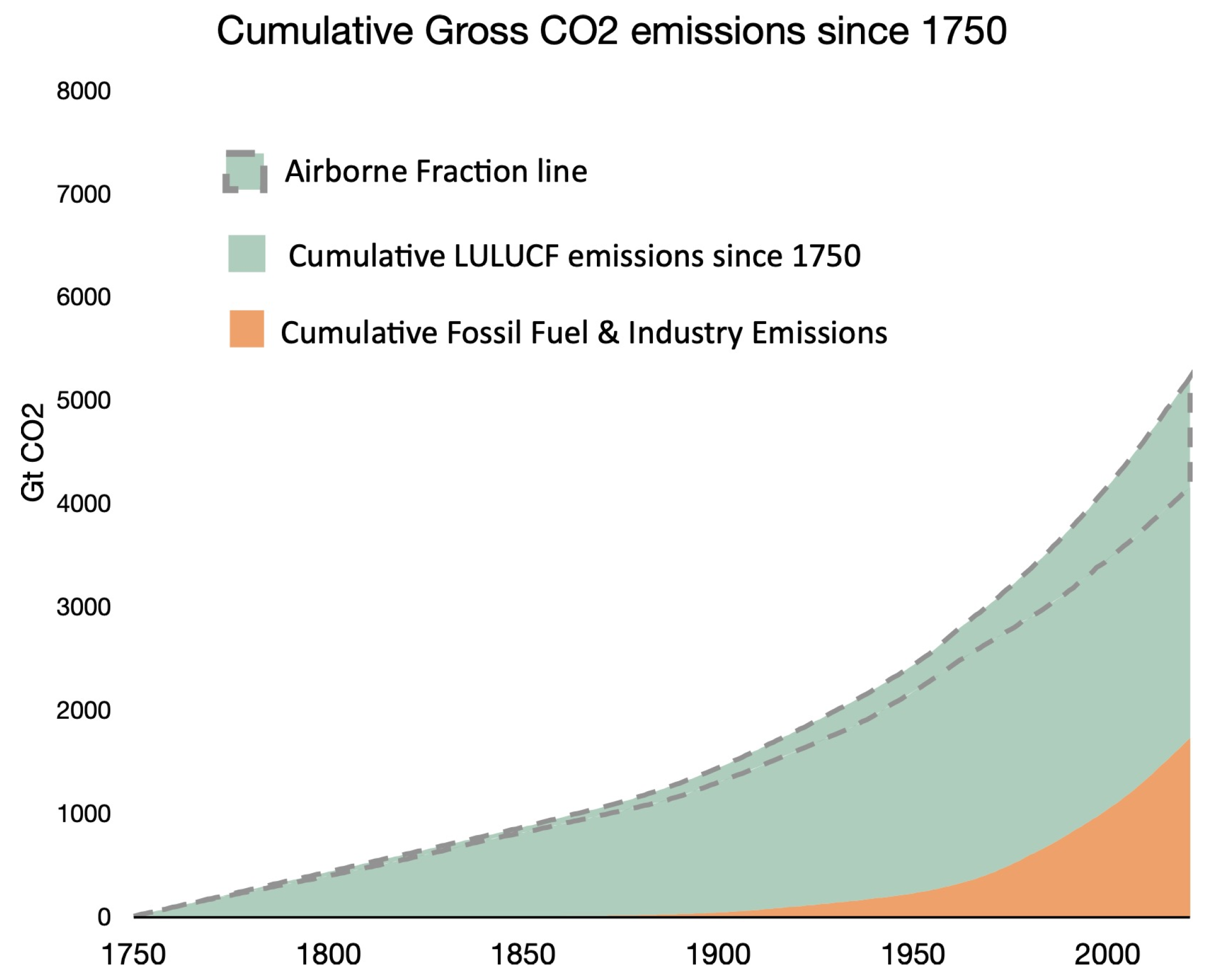
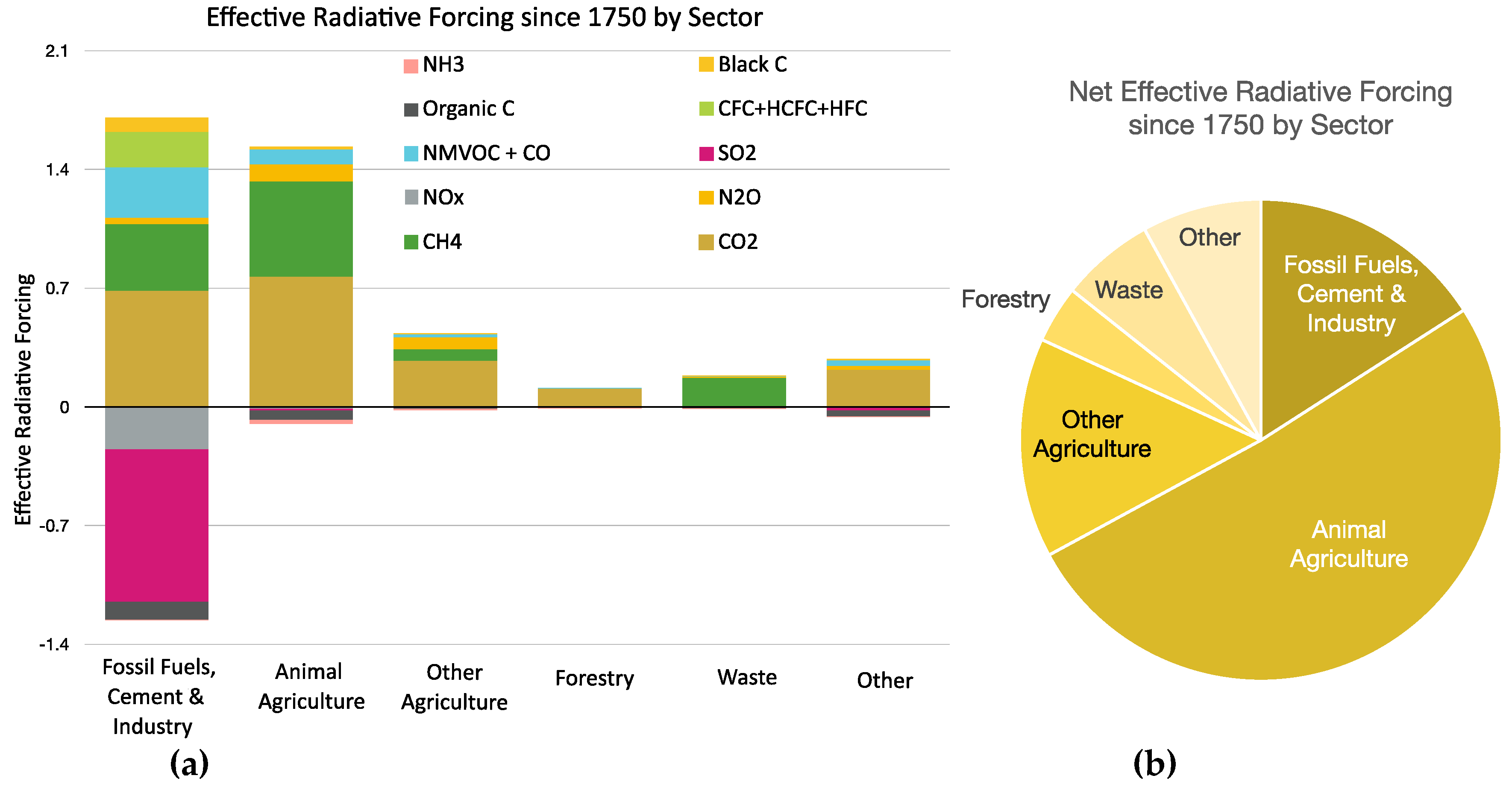
4. Discussion & Conclusions
Supplementary Materials
Author Contributions
Funding
Data Availability Statement
Acknowledgments
Conflicts of Interest
References
- Hawken, P. Drawdown: The Most Comprehensive Plan Ever Proposed to Reverse Global Warming; New York, NY, 2017;
- Griscom, B.W.; Adams, J.; Ellis, P.W.; Houghton, R.A.; Lomax, G.; Miteva, D.A.; Schlesinger, W.H.; Shoch, D.; Siikamäki, J.V.; Smith, P.; et al. Natural Climate Solutions. PNAS 2017, 114, 11645–11650. [Google Scholar] [CrossRef] [PubMed]
- Girardin, C.A.J.; Jenkins, S.; Seddon, N.; Allen, M.; Lewis, S.L.; Wheeler, C.E.; Griscom, B.W.; Malhi, Y. Nature-Based Solutions Can Help Cool the Planet — If We Act Now. Nature 2021, 593, 191–194. [Google Scholar] [CrossRef] [PubMed]
- Beck, S.; Mahony, M. The Politics of Anticipation: The IPCC and the Negative Emissions Technologies Experience. Global Sustainability 2018, 1, e8. [Google Scholar] [CrossRef]
- Grassi, G.; Schwingshackl, C.; Gasser, T.; Houghton, R.A.; Sitch, S.; Canadell, J.G.; Cescatti, A.; Ciais, P.; Federici, S.; Friedlingstein, P.; et al. Harmonising the Land-Use Flux Estimates of Global Models and National Inventories for 2000–2020. Earth System Science Data 2023, 15, 1093–1114. [Google Scholar] [CrossRef]
- UNFCCC Moving Towards the Enhanced Transparency Framework | UNFCCC. Available online: https://unfccc.int/enhanced-transparency-framework (accessed on 16 June 2023).
- McGlynn, E.; Li, S.; F. Berger, M.; Amend, M.; L. Harper, K. Addressing Uncertainty and Bias in Land Use, Land Use Change, and Forestry Greenhouse Gas Inventories. Climatic Change 2022, 170, 5. [CrossRef]
- Dreyfus, G.B.; Xu, Y.; Shindell, D.T.; Zaelke, D.; Ramanathan, V. Mitigating Climate Disruption in Time: A Self-Consistent Approach for Avoiding Both near-Term and Long-Term Global Warming. Proceedings of the National Academy of Sciences 2022, 119, e2123536119. [Google Scholar] [CrossRef] [PubMed]
- Wedderburn-Bisshop, G.; Rickards, L. Livestock’s Near-Term Climate Impact and Mitigation Policy Implications. Handbook of Research on Social Marketing and Its Influence on Animal Origin Food Product Consumption 2018, 37–57. [CrossRef]
- Houghton, R.A.; Nassikas, A.A. Negative Emissions from Stopping Deforestation and Forest Degradation, Globally. Global Change Biology 2018, 24, 350–359. [Google Scholar] [CrossRef] [PubMed]
- IPCC. 2006 IPCC Guidelines for National Greenhouse Gas Inventories; The Intergovernmental Panel on Climate Change: Hayama, Japan, 2006. [Google Scholar]
- Ballantyne, A.P.; Alden, C.B.; Miller, J.B.; Tans, P.P.; White, J.W.C. Increase in Observed Net Carbon Dioxide Uptake by Land and Oceans during the Past 50 Years. Nature 2012, 488, 70–72. [Google Scholar] [CrossRef] [PubMed]
- Dooley, K.; Gupta, A. Governing by Expertise: The Contested Politics of (Accounting for) Land-Based Mitigation in a New Climate Agreement. Int Environ Agreements 2017, 17, 483–500. [Google Scholar] [CrossRef]
- Crowther, T.W.; Glick, H.B.; Covey, K.R.; Bettigole, C.; Maynard, D.S.; Thomas, S.M.; Smith, J.R.; Hintler, G.; Duguid, M.C.; Amatulli, G.; et al. Mapping Tree Density at a Global Scale. Nature 2015, 525, 201–205. [Google Scholar] [CrossRef]
- Haverd, V.; Smith, B.; Canadell, J.G.; Cuntz, M.; Mikaloff-Fletcher, S.; Farquhar, G.; Woodgate, W.; Briggs, P.R.; Trudinger, C.M. Higher than Expected CO2 Fertilization Inferred from Leaf to Global Observations. Glob Chang Biol 2020, 26, 2390–2402. [Google Scholar] [CrossRef] [PubMed]
- van Marle, M.J.E.; van Wees, D.; Houghton, R.A.; Field, R.D.; Verbesselt, J.; van der Werf, G.R. New Land-Use-Change Emissions Indicate a Declining CO2 Airborne Fraction. Nature 2022, 603, 450–454. [Google Scholar] [CrossRef] [PubMed]
- Liang, M.-C.; Mahata, S.; Laskar, A.H.; Thiemens, M.H.; Newman, S. Oxygen Isotope Anomaly in Tropospheric CO2 and Implications for CO2 Residence Time in the Atmosphere and Gross Primary Productivity. Sci Rep 2017, 7, 13180. [Google Scholar] [CrossRef] [PubMed]
- Houghton, R.A.; Castanho, A. Annual Emissions of Carbon from Land Use, Land-Use Change, and Forestry from 1850 to 2020. Earth System Science Data 2023, 15, 2025–2054. [Google Scholar] [CrossRef]
- Keith, H.; Vardon, M.; Obst, C.; Young, V.; Houghton, R.; Mackey, B. Evaluating Nature-Based Solutions for Climate Mitigation and Conservation Requires Comprehensive Carbon Accounting. Science of The Total Environment 2021, 769, 144341. [Google Scholar] [CrossRef] [PubMed]
- Mackey, B.; Moomaw, W.; Lindenmayer, D.; Keith, H. Net Carbon Accounting and Reporting Are a Barrier to Understanding the Mitigation Value of Forest Protection in Developed Countries. Environ. Res. Lett. 2022, 17, 054028. [Google Scholar] [CrossRef]
- Houghton, R.A.; Nassikas, A.A. Global and Regional Fluxes of Carbon from Land Use and Land Cover Change 1850–2015. Global Biogeochemical Cycles 2017, 31, 456–472. [Google Scholar] [CrossRef]
- Arneth, A.; Sitch, S.; Pongratz, J.; Stocker, B.D.; Ciais, P.; Poulter, B.; Bayer, A.D.; Bondeau, A.; Calle, L.; Chini, L.P.; et al. Historical Carbon Dioxide Emissions Caused by Land-Use Changes Are Possibly Larger than Assumed. Nature Geosci 2017, 10, 79–84. [Google Scholar] [CrossRef]
- Rao, S.K. Animal Agriculture Is the Leading Cause of Climate Change - A Position Paper. Journal of the Ecological Society 2021, 32–33, 155–167, https://www.scienceopen.com/hosted-document?doi=10.54081/JES.027/13. [Google Scholar] [CrossRef]
- Bayer, A.D.; Lindeskog, M.; Pugh, T.A.M.; Anthoni, P.M.; Fuchs, R.; Arneth, A. Uncertainties in the Land-Use Flux Resulting from Land-Use Change Reconstructions and Gross Land Transitions. Earth System Dynamics 2017, 8, 91–111. [Google Scholar] [CrossRef]
- Hansis, E.; Davis, S.J.; Pongratz, J. Relevance of Methodological Choices for Accounting of Land Use Change Carbon Fluxes. Global Biogeochemical Cycles 2015, 29, 1230–1246. [Google Scholar] [CrossRef]
- Smil, V. Harvesting the Biosphere: What We Have Taken from Nature; MIT Press, 2013; ISBN 978-0-262-01856-2.
- Smith, P.; Bustamante, M.; Ahammad, H.; Clark, H.; Dong, H.; Elsiddig, E.; Haberl, H.; Harper, R.; House, oanna; Jafari, M.; et al. Agriculture, Forestry and Other Land Use (AFOLU). In IPCC AR5 WG3 Chapter 11 Agriculture, Forestry and Other Land Use (AFOLU); Cambridge University Press,: Cambridge UK and NY, 2014.
- Goodland, R.; Anhang, J. Livestock and Climate Change: What If the Key Actors in Climate Change Are Cows, Pigs and Chickens? World Watch Magazine 2009, 10–19. [Google Scholar]
- Szopa, S.; Naik, V.; Adhikary, B.; Artaxo, P.; Berntsen, T.; Collins, S.; Fuzzi, S.; Gallardo, L.; Kiendler-Scharr, A.; Klimont, Z.; et al. Short-Lived Climate Forcers. In Climate Change 2021: The Physical Science Basis. Contribution of Working Group I to the Sixth Assessment Report of the Intergovernmental Panel on Climate Change; Cambridge University Press: Cambridge, UK and New York, 2021; pp. 817–922.
- Quaas, J.; Jia, H.; Smith, C.; Albright, A.L.; Aas, W.; Bellouin, N.; Boucher, O.; Doutriaux-Boucher, M.; Forster, P.M.; Grosvenor, D.; et al. Robust Evidence for Reversal of the Trend in Aerosol Effective Climate Forcing. Atmospheric Chemistry and Physics 2022, 22, 12221–12239. [Google Scholar] [CrossRef]
- Allen, M.R.; Fuglestvedt, J.S.; Shine, K.P.; Reisinger, A.; Pierrehumbert, R.T.; Forster, P.M. New Use of Global Warming Potentials to Compare Cumulative and Short-Lived Climate Pollutants. Nature Climate Change 2016, 6, 773–776. [Google Scholar] [CrossRef]
- Allen, M.; Lynch, J.; Cain, M.; Frame, D.J. Climate Metrics for Ruminant Livestock. 2022.
- Abernethy, S.; Jackson, R.B. Global Temperature Goals Should Determine the Time Horizons for Greenhouse Gas Emission Metrics. Environ. Res. Lett. 2022, 17, 024019. [Google Scholar] [CrossRef]
- Brazzola, N.; Wohland, J.; Patt, A. Offsetting Unabated Agricultural Emissions with CO2 Removal to Achieve Ambitious Climate Targets. PLoS ONE 2021, 16, e0247887. [Google Scholar] [CrossRef] [PubMed]
- Matthews, H.D.; Gillett, N.P.; Stott, P.A.; Zickfeld, K. The Proportionality of Global Warming to Cumulative Carbon Emissions. Nature 2009, 459, 829–832. [Google Scholar] [CrossRef] [PubMed]
- Longmire, A.; Taylor, C.; Wedderburn-Bisshop, G. Land Use: Agriculture and Forestry Discussion Paper; Beyond Zero Emissions; Melbourne Sustainable Society Institute: Melbourne, Vic, 2014;
- Ascui, F.; Lovell, H. As Frames Collide. Accounting, Auditing and Accountability 2011, 24, 978–999. [Google Scholar] [CrossRef]
- Bryngelsson, D.; Wirsenius, S.; Hedenus, F.; Sonesson, U. How Can the EU Climate Targets Be Met? A Combined Analysis of Technological and Demand-Side Changes in Food and Agriculture. Food Policy 2016, 59, 152–164. [Google Scholar] [CrossRef]
- Bhan, M.; Gingrich, S.; Nicolas, R.; Le Noe, J.; Kastner, T.; Matej, S.; Schwarzmüller, F.; Erb, K.-H. Quantifying and Attributing Land Use-Induced Carbon Emissions to Biomass Consumption: A Critical Assessment of Existing Approaches. Journal of Environmental Management 2021, 112228. [Google Scholar] [CrossRef]
- Searchinger, T.D.; Wirsenius, S.; Beringer, T.; Dumas, P. Assessing the Efficiency of Changes in Land Use for Mitigating Climate Change. Nature 2018, 564, 249–253. [Google Scholar] [CrossRef] [PubMed]
- Yang, X.; Tan, M. Attributing Global Land Carbon Loss to Regional Agricultural and Forestry Commodity Consumption. Environ. Sci. Technol. 2021, 55, 823–831. [Google Scholar] [CrossRef] [PubMed]
- Hayek, M.N.; Harwatt, H.; Ripple, W.J.; Mueller, N.D. The Carbon Opportunity Cost of Animal-Sourced Food Production on Land. Nature Sustainability 2021, 1–4. [Google Scholar] [CrossRef]
- Eisen, M.B.; Brown, P.O. Rapid Global Phaseout of Animal Agriculture Has the Potential to Stabilize Greenhouse Gas Levels for 30 Years and Offset 68 Percent of CO2 Emissions This Century. PLOS Climate 2022, 1, e0000010. [Google Scholar] [CrossRef]
- Sun, Z.; Scherer, L.; Tukker, A.; Spawn-Lee, S.A.; Bruckner, M.; Gibbs, H.K.; Behrens, P. Dietary Change in High-Income Nations Alone Can Lead to Substantial Double Climate Dividend. Nat Food 2022, 3, 29–37. [Google Scholar] [CrossRef] [PubMed]
- Erb, K.-H.; Kastner, T.; Plutzar, C.; Bais, A.L.S.; Carvalhais, N.; Fetzel, T.; Gingrich, S.; Haberl, H.; Lauk, C.; Niedertscheider, M.; et al. Unexpectedly Large Impact of Forest Management and Grazing on Global Vegetation Biomass. Nature 2018, 553, 73–76. [Google Scholar] [CrossRef] [PubMed]
- Crowther, T.W.; Glick, H.; Maynard, D.; Ashley-Cantello, W.; Evans, T.; Routh, D. Predicting Global Forest Reforestation Potential. bioRxiv 2017, 210062. [Google Scholar] [CrossRef]
- Obermeier, W.A.; Nabel, J.E.M.S.; Loughran, T.; Hartung, K.; Bastos, A.; Havermann, F.; Anthoni, P.; Arneth, A.; Goll, D.S.; Lienert, S.; et al. Modelled Land Use and Land Cover Change Emissions – a Spatio-Temporal Comparison of Different Approaches. Earth System Dynamics 2021, 12, 635–670. [Google Scholar] [CrossRef]
- Gasser, T.; Crepin, L.; Quilcaille, Y.; Houghton, R.A.; Ciais, P.; Obersteiner, M. Historical CO Emissions from Land Use and Land Cover Change and Their Uncertainty. Biogeosciences 2020, 17, 4075–4101. [Google Scholar] [CrossRef]
- Chen, C.; Riley, W.J.; Prentice, I.C.; Keenan, T.F. CO2 Fertilization of Terrestrial Photosynthesis Inferred from Site to Global Scales. Proceedings of the National Academy of Sciences 2022, 119, e2115627119. [Google Scholar] [CrossRef]
- Kaplan, J.O.; Krumhardt, K.M.; Ellis, E.C.; Ruddiman, W.F.; Lemmen, C.; Goldewijk, K.K. Holocene Carbon Emissions as a Result of Anthropogenic Land Cover Change. The Holocene 2011, 21, 775–791. [Google Scholar] [CrossRef]
- Yu, Z. Holocene Carbon Flux Histories of the World’s Peatlands: Global Carbon-Cycle Implications. The Holocene 2011, 21, 761–774. [Google Scholar] [CrossRef]
- Shrestha, A.; Eshpeter, S.; Li, N.; Li, J.; Nile, J.O.; Wang, G. Inclusion of Forestry Offsets in Emission Trading Schemes: Insights from Global Experts. J. For. Res. 2022, 33, 279–287. [Google Scholar] [CrossRef]
- Schenuit, F.; Gidden, M.J.; Boettcher, M.; Brutschin, E.; Fyson, C.; Gasser, T.; Geden, O.; Lamb, W.F.; Mace, M.J.; Minx, J.; et al. Secure Robust Carbon Dioxide Removal Policy through Credible Certification. Commun Earth Environ 2023, 4, 1–4. [Google Scholar] [CrossRef]
- Newman, P.W.G. Net Zero in the Maelstrom: Professional Practice for Net Zero in a Time of Turbulent Change. Sustainability 2023, 15, 4810. [Google Scholar] [CrossRef]
- Harvey, F.; editor, F.H.E. Greenwashing or a Net Zero Necessity? Climate Scientists on Carbon Offsetting. The Guardian 2023.
- Greenfield, P. Revealed: More than 90% of Rainforest Carbon Offsets by Biggest Certifier Are Worthless, Analysis Shows. The Guardian 2023.
- NATCARB National Carbon Sequestration Database and Geographic Information System (NATCARB) Sources Spatial Database of Stationary Sources of Atmospheric Carbon Dioxide (CO2) Emissions | Data Basin. Available online: https://databasin.org/datasets/8f9de65926ab4e32bbe763df100a1398/ (accessed on 24 October 2023).
- CER Emissions Reduction Fund Project Register. Available online: https://www.cleanenergyregulator.gov.au/ERF/project-and-contracts-registers/project-register (accessed on 24 October 2023).
- Jia, G.; Shevliakova, E.; Artaxo, P.; Noblet-Ducoudre, N.; Houghton, R.; House, J.; Kitajima, K.; Lennard, C.; Popp, A.; Sirin, A.; et al. Land–Climate Interactions. In Climate Change and Land: An IPCC special report on climate change, desertification, land degradation, sustainable land management, food security, and greenhouse gas fluxes in terrestrial ecosystems; Shukla, P., Skea, J., Calvo Buendia, E., Masson-Delmotte, V., Portner, H., Roberts, D., Zhai, P., Slade, R., Connors, S., van Diemen, R., Haughey, E., Luz, S., Pathak, M., Petzold, J., Portugal Pereira, J., Vyas, P., Huntley, E., Kissick, K., Belkacemi, M., Malley, J., Eds.; Intergovernmental Panel on Climate Change, 2019.
- Qin, Y.; Xiao, X.; Wigneron, J.-P.; Ciais, P.; Brandt, M.; Fan, L.; Li, X.; Crowell, S.; Wu, X.; Doughty, R.; et al. Carbon Loss from Forest Degradation Exceeds That from Deforestation in the Brazilian Amazon. Nat. Clim. Chang. 2021, 11, 442–448. [Google Scholar] [CrossRef]
- Winkler, K.; Fuchs, R.; Rounsevell, M.; Herold, M. Global Land Use Changes Are Four Times Greater than Previously Estimated. Nat Commun 2021, 12, 2501. [Google Scholar] [CrossRef]
- Global Carbon and Other Biogeochemical Cycles and Feedbacks. In Climate Change 2021 – The Physical Science Basis: Working Group I Contribution to the Sixth Assessment Report of the Intergovernmental Panel on Climate Change; Canadell, Monterio, P., Costa, M., Cotrim da Cunha, L., Cox, P., Eliseev, A., Henson, S., Ishii, M., Jaccard, S., Koven, C., Lohila, A., Patra, P., Piao, S., Rogelj, J., Syampungani, S., Zaehle, S., Zickfeld, K., Eds.; Cambridge University Press: Cambridge, 2021; pp. 673–816 ISBN 978-1-00-915788-9.
- Peng, L.; Searchinger, T.D.; Zionts, J.; Waite, R. The Carbon Costs of Global Wood Harvests. Nature 2023, 1–6. [Google Scholar] [CrossRef] [PubMed]
- Forster, P.; Storelvmo, T.; Armour, K.; Collins, W.; Dufresne, J.-L.; Frame, D.; Lunt, D.; Mauritsen, T.; Palmer, M.; Watanabe, M.; et al. The Earth’s Energy Budget, Climate Feedbacks, and Climate Sensitivity. In Climate Change 2021: The Physical Science Basis. Contribution of Working Group I to the Sixth Assessment Report of the Intergovernmental Panel on Climate Change; Cambridge University Press, Cambridge, United Kingdom and New York, USA, 2021 ISBN. [CrossRef]
- Friedlingstein, P.; O’Sullivan, M.; Jones, M.W.; Andrew, R.M.; Gregor, L.; Hauck, J.; Le Quéré, C.; Luijkx, I.T.; Olsen, A.; Peters, G.P.; et al. Global Carbon Budget 2022. Earth System Science Data 2022, 14, 4811–4900. [Google Scholar] [CrossRef]
- Hoesly, R.M.; Smith, S.J.; Feng, L.; Klimont, Z.; Janssens-Maenhout, G.; Pitkanen, T.; Seibert, J.J.; Vu, L.; Andres, R.J.; Bolt, R.M.; et al. Historical (1750–2014) Anthropogenic Emissions of Reactive Gases and Aerosols from the Community Emissions Data System (CEDS). Geoscientific Model Development 2018, 11, 369–408. [Google Scholar] [CrossRef]
- Graven, H.; Keeling, R.F.; Rogelj, J. Changes to Carbon Isotopes in Atmospheric CO2 Over the Industrial Era and Into the Future. Global Biogeochemical Cycles 2020, 34, e2019GB006170. [Google Scholar] [CrossRef]
- Walker, W.S.; Gorelik, S.R.; Cook-Patton, S.C.; Baccini, A.; Farina, M.K.; Solvik, K.K.; Ellis, P.W.; Sanderman, J.; Houghton, R.A.; Leavitt, S.M.; et al. The Global Potential for Increased Storage of Carbon on Land. Proceedings of the National Academy of Sciences 2022, 119, e2111312119. [Google Scholar] [CrossRef] [PubMed]
- Padarian, J.; Minasny, B.; McBratney, A.; Smith, P. Soil Carbon Sequestration Potential in Global Croplands. PeerJ 2022, 10, e13740. [Google Scholar] [CrossRef] [PubMed]
- Xu, L.; Saatchi, S.S.; Yang, Y.; Yu, Y.; Pongratz, J.; Bloom, A.A.; Bowman, K.; Worden, J.; Liu, J.; Yin, Y.; et al. Changes in Global Terrestrial Live Biomass over the 21st Century. Science Advances 2021, 7, eabe9829. [Google Scholar] [CrossRef] [PubMed]
- Hansen, J.; Kharecha, P.; Sato, M. Climate Forcing Growth Rates: Doubling down on Our Faustian Bargain. Environ. Res. Lett. 2013, 8, 011006. [Google Scholar] [CrossRef]
- Samset, B.H.; Sand, M.; Smith, C.J.; Bauer, S.E.; Forster, P.M.; Fuglestvedt, J.S.; Osprey, S.; Schleussner, C.-F. Climate Impacts From a Removal of Anthropogenic Aerosol Emissions. Geophysical Research Letters 2018, 45, 1020–1029. [Google Scholar] [CrossRef] [PubMed]
- Chowdhury, S.; Pozzer, A.; Haines, A.; Klingmüller, K.; Münzel, T.; Paasonen, P.; Sharma, A.; Venkataraman, C.; Lelieveld, J. Global Health Burden of Ambient PM2.5 and the Contribution of Anthropogenic Black Carbon and Organic Aerosols. Environment International 2022, 159, 107020. [Google Scholar] [CrossRef]
- Lelieveld, J.; Klingmüller, K.; Pozzer, A.; Burnett, R.T.; Haines, A.; Ramanathan, V. Effects of Fossil Fuel and Total Anthropogenic Emission Removal on Public Health and Climate. PNAS 2019, 116, 7192–7197. [Google Scholar] [CrossRef]
- van der Werf, G.R.; Randerson, J.T.; Giglio, L.; van Leeuwen, T.T.; Chen, Y.; Rogers, B.M.; Mu, M.; van Marle, M.J.E.; Morton, D.C.; Collatz, G.J.; et al. Global Fire Emissions Estimates during 1997–2016. Earth System Science Data 2017, 9, 697–720. [Google Scholar] [CrossRef]
- Millington, J.D.A.; Perkins, O.; Smith, C. Human Fire Use and Management: A Global Database of Anthropogenic Fire Impacts for Modelling. Fire 2022, 5, 87. [Google Scholar] [CrossRef]
- Lauk, C.; Erb, K.-H. Biomass Consumed in Anthropogenic Vegetation Fires: Global Patterns and Processes. Ecological Economics 2009, 69, 301–309. [Google Scholar] [CrossRef]
- Pendrill, F.; Gardner, T.A.; Meyfroidt, P.; Persson, U.M.; Adams, J.; Azevedo, T.; Bastos Lima, M.G.; Baumann, M.; Curtis, P.G.; De Sy, V.; et al. Disentangling the Numbers behind Agriculture-Driven Tropical Deforestation. Science 2022, 377, eabm9267. [Google Scholar] [CrossRef] [PubMed]
- FAO.Forest Resource Assessment 2020 Remote Sensing Survey; FAO: Rome, 2022; ISBN 978-92-5-136147-4.
- Gulev, S.; Thorne, P.; Ahn, J.; Dentener, F.; Domingues, C.; Gerland, S.; Gong, D.; Kaufman, D.; Nnamchi, H.; Quaas, J.; et al. Changing State of the Climate System. In Climate Change 2021: The Physical Science Basis. Contribution of Working Group I to the Sixth Assessment Report of the Intergovernmental Panel on Climate Change; Cambridge University Press, Cambridge, United Kingdom and New York, USA, 2021.
- Thornhill, G.D.; Collins, W.J.; Kramer, R.J.; Olivié, D.; Skeie, R.B.; O’Connor, F.M.; Abraham, N.L.; Checa-Garcia, R.; Bauer, S.E.; Deushi, M.; et al. Effective Radiative Forcing from Emissions of Reactive Gases and Aerosols – a Multi-Model Comparison. Atmospheric Chemistry and Physics 2021, 21, 853–874. [Google Scholar] [CrossRef]
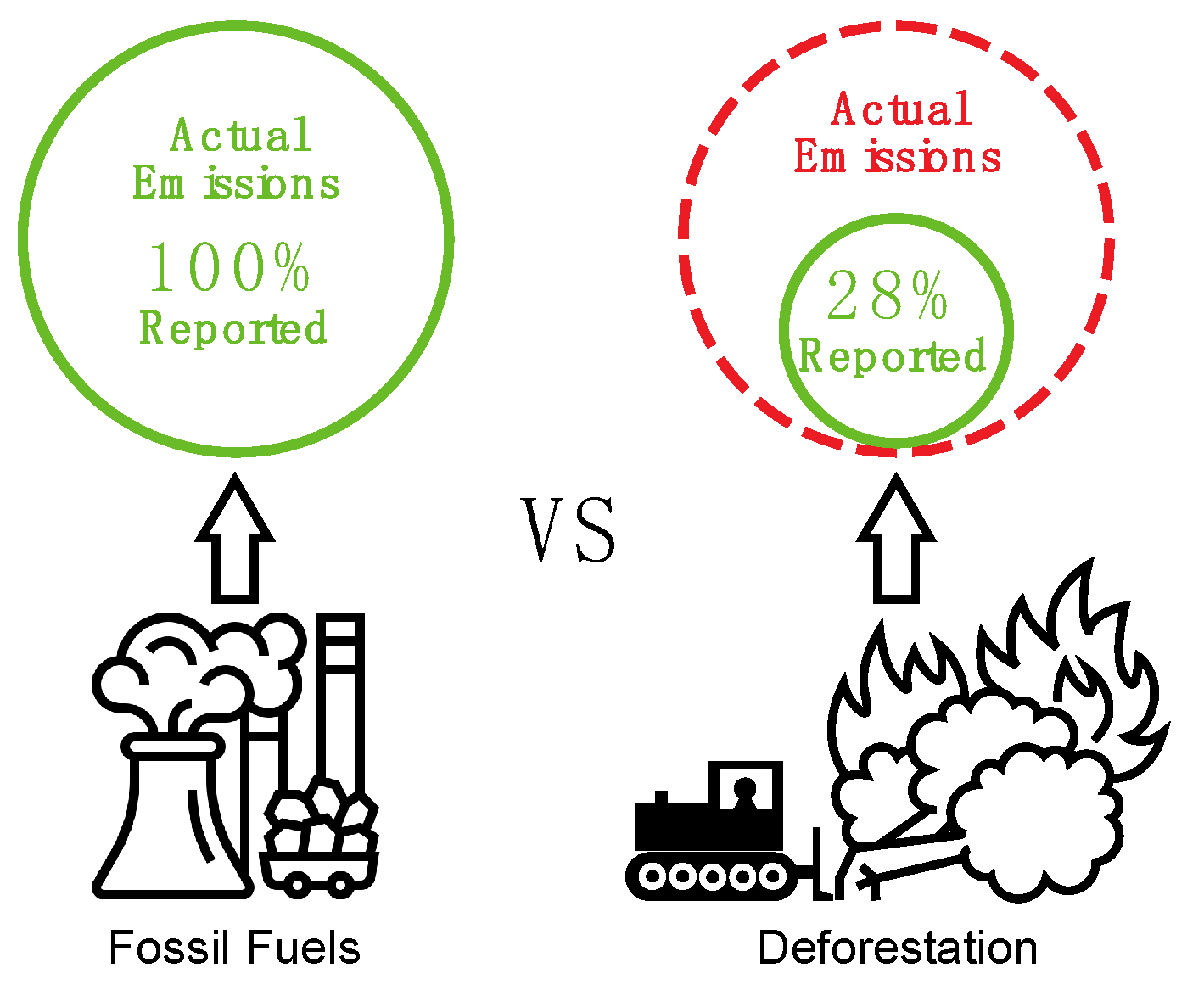
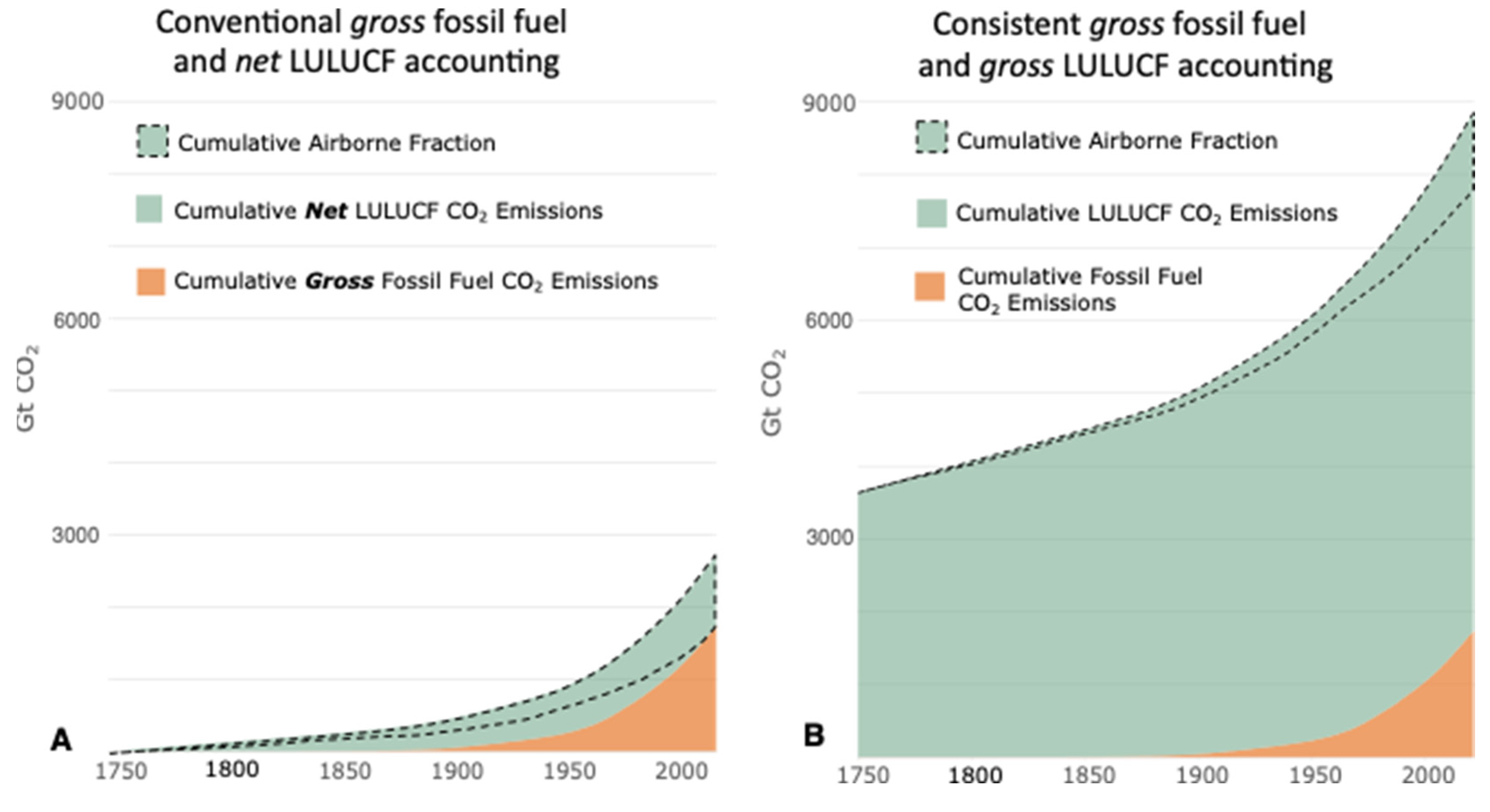
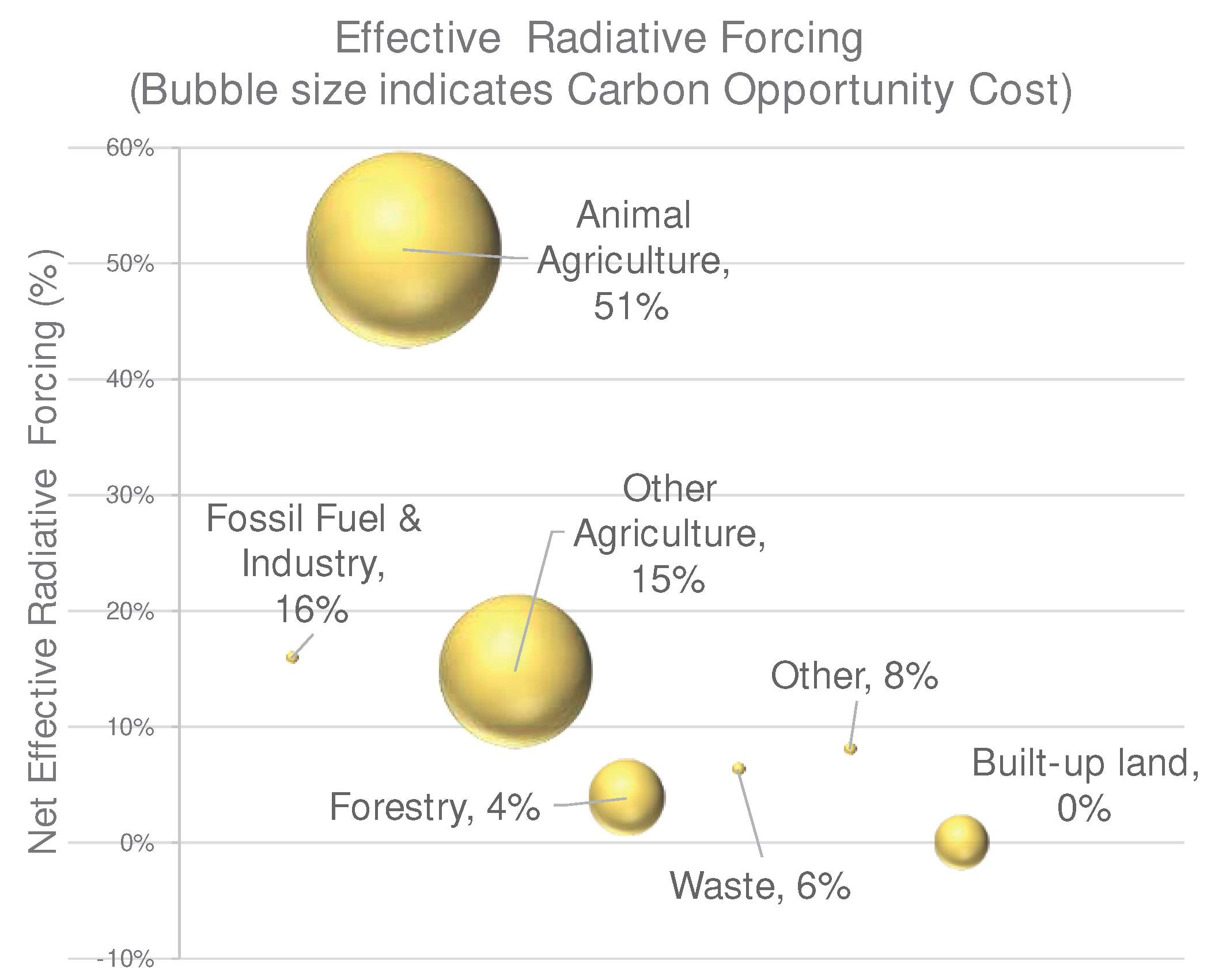
| Proposed Accounting Change | Description |
|---|---|
| 1. Consistent accounting of CO2 sources | Correcting inconsistent Gross accounting as applied to CO2 emissions from fossil fuels and Net accounting applied to CO2 from land use/land use change and forestry (LULUCF). |
| 2. Aggregate biosphere sinks | Removing the artificial distinction between drawdown on ‘intact’ and ‘managed’ land |
| 3. Sector accounting to include all emissions: heating and cooling | Correcting partial accounting: cooling emissions are rarely associated with sectors |
| 4. Clearly attribute land use emissions to industries/sectors responsible | Introducing new LULUCF categories to allow transparent attribution to sectors |
| 5. Compare sectors using emissions-based Effective Radiative Forcing (ERF) of individual gases, rather than conventional GWP100 | Major advances have been made in modelling ERF (IPCC AR6, 2021), making sector contributions more transparent and avoiding contentious emission comparison metrics |
| 6. Include Carbon Opportunity Cost (COC) | Explicitly placing the major drawdown mechanism (biosphere sequestration) into carbon accounting |
| 7. Accounting for Drawdown | Devising a new accounting framework that allows for COC and drawdown, with explicit spatial data |
Disclaimer/Publisher’s Note: The statements, opinions and data contained in all publications are solely those of the individual author(s) and contributor(s) and not of MDPI and/or the editor(s). MDPI and/or the editor(s) disclaim responsibility for any injury to people or property resulting from any ideas, methods, instructions or products referred to in the content. |
© 2023 by the authors. Licensee MDPI, Basel, Switzerland. This article is an open access article distributed under the terms and conditions of the Creative Commons Attribution (CC BY) license (http://creativecommons.org/licenses/by/4.0/).

